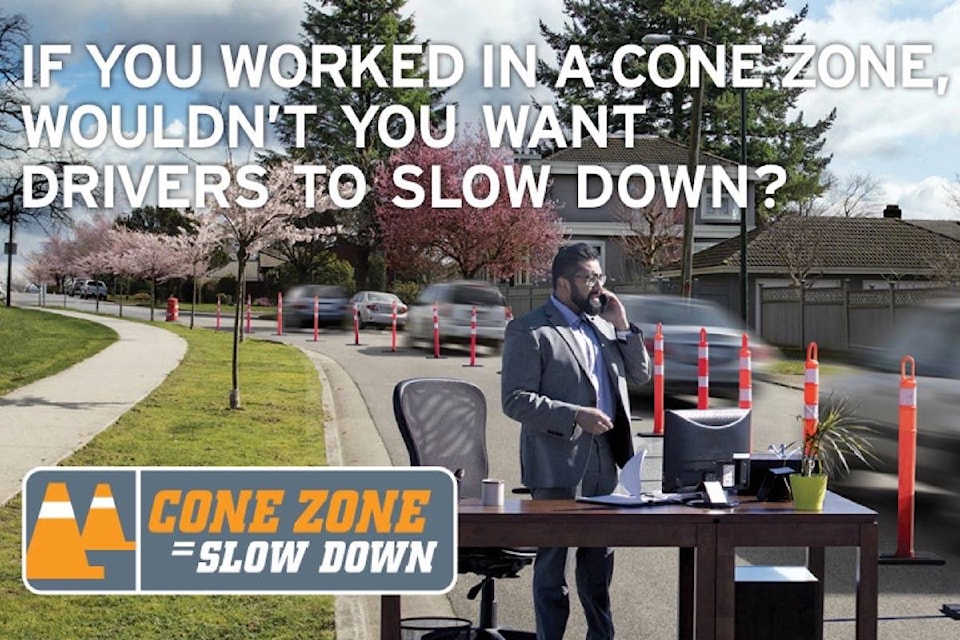Summertime is when construction and repair work on the province’s highways and roads increases, as crews work to complete projects during the hours of long daylight and dry weather. Summer is also when more motorists hit the road; and Sarina Hanschke, who is with the traffic control program of the BC Construction Safety Alliance, wants to remind drivers to be careful around construction zones.
“Between 2007 and 2016, 15 roadside workers were killed and 229 were injured and missed time from work as a result of being hit by a motor vehicle,” she tells The Journal by email. She notes that there are a lot of different types of work going on in a construction zone, including machine ops, digging, paving, water and electrical work, and more. “Because working in close proximity to traffic is dangerous no matter how you slice it, it’s extremely difficult to determine which worker is at the most risk.”
She adds, however, that traffic control people (flaggers) are often considered most at risk, because their role may include physically stopping and interacting with traffic. “And tow truck drivers are especially vulnerable, as they often work alone at the roadside with sometimes as little as a flashing amber light and a hi-visibility vest to get the attention of motorists.
“The work they do often requires that their attention be away from oncoming traffic, and they are often bending over or stooping or kneeling low to the ground, sometimes in positions without an escape route.”
Daniel Hutchins, the Interior Roads operations manager for our area, agrees that flag people are most at risk from motorists. “They’re also the people drivers take their aggression out on, so they get the worst of it both ways.” He notes that distracted driving has taken over from speeding as the number one hazard that could lead to someone being injured in a construction zone.
“People slow down, and then take the opportunity to look at their smartphones or the stereo. I see a real potential there for accidents.”
Hutchins credits the “Cone Zone” campaign (http://www.conezonebc.com/) with helping to educate drivers and roadside workers about steps they can take to reduce the risk of accidents. “Drivers’ speeds have really dropped, so the campaign is having positive effects. “ He notes that increased fines and points for speeding in a construction zone also help. “When you get a ticket it really hits hard.”
Hanschke agrees that distracted driving through construction zones is a common driving error. “It greatly impacts a driver’s perception and reaction time, their ability to perceive the hazard, recognize it or its potential threat, decide how to react to it, and physically perform that act safely and efficiently.” She also notes that in our tightly scheduled lives, there can be an apathetic reaction on the part of drivers to the presence of roadside workers.
“Errors in construction zones often happen because the driver is in a rush to get somewhere. A driver may become upset and anxious because of time restraints and the delays they are encountering. Cars often pass within a few inches of workers on roadways, at a rate of speed that is not considerate of the space that workers needs to perform their work.”
She says that getting upset or anxious behind the wheel can impair a driver’s observation and reduce their reaction time; lead to a failure to acknowledge a change in the driving situation, such as a lane closing or being stopped by a traffic control person; an inability to predict what might happen, such as a worker stepping onto the road or a piece of equipment moving; and poor decision making, such as failing to stop for a traffic control person or driving the wrong way.
Hanschke adds that drivers being upset or anxious because of road construction can lead to hazardous or aggressive behaviour. Behaviours witnessed in the work zone when drivers are enraged include excessive speeding on the approach to the work zone; tailgating other vehicles driving at adequate speeds; honking the horn; intentionally knocking or running over traffic control signs; rude gestures; revving engines; weaving in the traffic lineup to see ahead in the work zone; and driving on the shoulder.
“When you see a roadside work zone, please think of someone you know in your community who works on the roadside,” she says. “Their families are counting on them to come home at the end of the day.”
Asked how drivers can prepare themselves for encountering construction zones, Hanschke says to plan for an extra 20 to 30 minutes of travel time, and know before you go by checking www.drivebc.com, where there is a list of conditions and events on roads around the province.
Hutchins agrees. “Check with DriveBC. You can check your route, and maybe delay your departure time or plan an alternate route.
“And be patient. That’s the number one thing that comes to mind. It’s easy to get frustrated, especially at big jobs where you have to drive slowly for several kilometres. Understand that the delay is there for road improvement, and you will enjoy the improvement after it’s done.”
